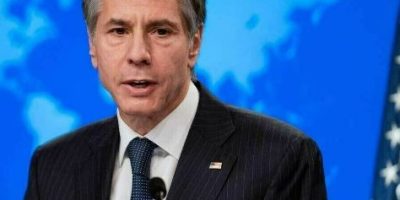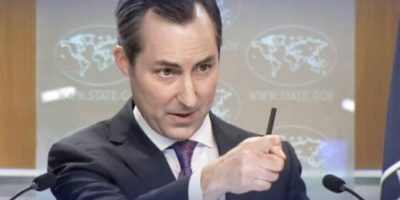North Korea Missile Tests, ‘Very Standard’ to Trump, Show Signs of Advancing Arsenal

As North Korea fired off a series of missiles in recent months — at least 18 since May — President Trump has repeatedly dismissed their importance as short-range and “very standard” tests. And although he has conceded “there may be a United Nations violation,” the president says any concerns are overblown.
Kim Jong-un, North Korea’s leader, Mr. Trump explained recently, just “likes testing missiles.”
Now, American intelligence officials and outside experts have come to a far different conclusion: that the launchings downplayed by Mr. Trump, including two late last month, have allowed Mr. Kim to test missiles with greater range and maneuverability that could overwhelm American defenses in the region.
Japan’s defense minister, Takeshi Iwaya, told reporters in Tokyo last week that the irregular trajectories of the most recent tests were more evidence of a program designed to defeat the defenses Japan has deployed, with American technology, at sea and on shore.
Mr. Kim’s flattery of Mr. Trump with beguiling letters and episodic meetings offering vague assurances of eventual nuclear disarmament, some outside experts say, are part of what they call the North Korean leader’s strategy of buying time to improve his arsenal despite all the sanctions on North Korea.
The rapid improvements in the short-range missiles not only put Japan and South Korea in increased danger, but also threaten at least eight American bases in those countries housing more than 30,000 troops, according to an analysis of the missile ranges by The New York Times. Such missiles, experts say, could be designed to carry either conventional or nuclear warheads.
“Kim is exploiting loopholes in his agreements with President Trump pretty brilliantly,” said Vipin Narang, a political-science professor at M.I.T. who studies North Korean weapon advances. “These are mobile-launched, they move fast, they fly very low and they are maneuverable. That’s a nightmare for missile defense. And it’s only a matter of time before those technologies are migrated to longer-range missiles.”
President Trump says that Mr. Kim committed to him during a meeting in Singapore 14 months ago that he would refrain from testing intercontinental ballistic missiles and conducting nuclear tests while negotiations are underway, and he has kept those promises even though there have been no substantive talks since a second summit in Hanoi in February resulted in an impasse.
But North Korean state-run media made clear last week that the country feels no such limits when it comes to improving other missile technologies, saying it would never accede to the West’s demand “for disarmament under pressure and appeasement of ‘international society.’”
By pushing ahead with short-range missile tests, though, Mr. Kim has managed to sow divisions between the United States and its main allies in Asia.
That was evident recently when Mr. Trump met with Prime Minister Shinzo Abe of Japan and once again dismissed the importance of the launches. Mr. Abe, usually an ardent supporter of Mr. Trump, immediately contradicted him, telling reporters that all of North Korea’s tests have violated United Nations Security Council resolutions.
Although Mr. Trump acknowledged that “there may be a United Nations violation,” he appears unwilling to make statements or take actions that could call into question what he considers his warm relationship with Mr. Kim, which the president believes is crucial to ending decades-long hostilities with the North.
For his part, Mr. Kim has not been shy about touting the latest missile advances, attending many of the tests and releasing photographs of post-launch celebrations with his missile brain trust, a group of officers who have steadily continued weapons development while diplomacy has sputtered.
An estimate by the Defense Intelligence Agency, circulated to select officials inside the United States government this summer, estimates that the North has also produced enough fuel for roughly a dozen new nuclear weapons since the historic talks in Singapore. Other intelligence agencies have “more conservative numbers,” one former senior official said, but all point to an expanding cache of bombs.
Defense Secretary Mark Esper told reporters Wednesday that “we are concerned” about North Korea’s missile tests, but that “we’re not going to overreact” in the interest of preserving efforts at a diplomatic solution.
Even so, Secretary of State Mike Pompeo, who has taken the lead in the effort to rid North Korea of its nuclear weapons and missiles, has hinted to foreign counterparts in private meetings in recent weeks that he is fearful the administration is being strung along, according to Japanese and South Korean officials.
In public, Mr. Pompeo is more circumspect. He recently told CBS, “We haven’t gotten back to the table as quickly as we would have hoped, but we’ve been pretty clear all along we knew there would be bumps along the way.”
The bumps, though, have gotten much larger in recent months as the North began lobbing missile after missile aloft, testing at least three new varieties. The tests have showcased the North’s ability to consistently launch solid-fuel missiles that are easier to hide in the mountains, and which could be quickly deployed on mobile launchers and fired before the United States could respond.
Some are also part of a new generation that can fly low and maneuver in unpredictable paths, likely defeating the standard missile defenses the United States has installed in the region. In at least one case, Mr. Kim appears to have built upon a well-tested Russian design — though it is unclear how he obtained it.
Even with the barrage of tests, Mr. Kim has kept up his personal praise for Mr. Trump. Just last month the president told reporters he had received another “really beautiful letter” from the North Korean leader. Mr. Trump referred to the most recent letter again last week, concluding that he was sure Mr. Kim would move toward full denuclearization.
“Kim understands what he is doing,” said Mr. Narang, the M.I.T. professor. “He likely thinks Trump can live with a nuclear North Korea as long as they don’t test ICBMs and nuclear weapons, which would humiliate Trump and take away the perception he has achieved of some kind of victory” with his diplomacy.
Administration officials dispute that view and say the tests are a symptom of a North desperately trying to end “maximum pressure,” which is how Mr. Pompeo describes the sanctions the United States has imposed on the country. And there is some evidence for his position: North Korea’s official media recently described the secretary of state as a “die-hard toxin.”
If there is any lesson to be taken from the latest North Korean provocations, it is that Mr. Kim clearly has a maximum pressure strategy of his own.
In 2015 and 2016 the country’s missile tests were failing at an astoundingly high rate. Some intelligence officials and outside experts tied at least some of those setbacks to a covert Pentagon effort to sabotage the launches with cyber and electronic strikes.
But by 2017, Mr. Trump’s first year in office, Mr. Kim had adopted new designs and conducted 14 successful launches, mostly of medium- and long-range missiles, for the first time raising the specter that he might be able to reach all of the United States. At the same time, he conducted a series of nuclear tests, including of its largest weapon yet, which he described as a hydrogen bomb.
Those successes prompted Mr. Trump to first warn of “fire and fury like the world has never seen,” then to begin the diplomatic dance toward the Singapore summit last year, the first time a sitting American president had met any member of the Kim family. After the meeting, Mr. Trump said that North Korea was on the road to disarmament, telling reporters he expected they would see major results within six months.
For almost a year afterward, Mr. Kim appeared to refrain from firing missiles, perhaps in the hope that the Trump administration would ease sanctions.
Then the diplomacy stalled at the second summit, in Hanoi. Mr. Kim offered to close the North’s major nuclear complex at Yongbyon — but not other nuclear facilities or any missile sites — in return for the lifting of the most severe sanctions. Mr. Trump rejected that offer at the insistence of Mr. Pompeo and John R. Bolton, his hawkish national security adviser.
Mr. Kim now appears to be reverting to the tactic that worked for him two years ago: escalating tests to demonstrate new capabilities.
“Their stock-in-trade has always been to press the edge of the envelope and see what they can get away with,” said Vann H. Van Diepen, a top official on weapons of mass destruction in the Office of the Director of National Intelligence until 2009.
The recent bout began in early May when the North fired a 30-foot-tall missile from an eight-wheeled truck. Analysts said it was a solid-fuel rocket that can be launched in minutes — unlike liquid-fueled missiles, which can take hours of preparation.
In all, the North conducted eight flight tests of the new missile in May, July and August. Its maximum range was found to be roughly 430 miles, according to the Center for Nonproliferation Studies, a private group in Monterey, Calif. The missile, if perfected, could target all of South Korea, including at least six American bases, and parts of southern Japan, including two large bases.
A number of Western experts said the new missile closely resembled a Russian Iskander missile, which can fly on low trajectories through the atmosphere and then dive on targets to avoid interception.
A day after the missile’s debut, Markus Schiller, a rocket analyst based in Munich, Germany, posted on Twitter a pair of photographs that he said showed significant similarities to a Russian Iskander.
Other experts disagree, based on their own interpretations of the photographic evidence, though any Russian help to the North’s missile program would violate United Nations sanctions.
The biggest concern over the Iskander-like missile is that it could defeat antimissile batteries, including the land-based Patriot in South Korea and the ship-based Aegis.
North Korea debuted another type of missile in late July and early August, along with a new launching system. Mr. Van Diepen, the former top American official on weapons of mass destruction, described the system in 38 North, a respected publication on North Korea, as a new generation of weapon that could fire an unknown number of missiles simultaneously. The older type could fire eight.
The range of the newly tested missile, he wrote, was 155 miles, about 40 miles farther than the older version. Mr. Van Diepen said it would increase the North’s ability to subject American and South Korean targets to “saturation attacks,” which can also defeat antimissile defenses.
North Korea tested a third new missile twice in early August. Analysts have yet to determine what advances it might represent.
Then, late last month, the North fired two projectiles from what it called a “super-large multiple rocket launcher.” Mr. Narang of M.I.T. said the system appeared new, making it perhaps the fourth missile system to debut this year and another iteration of a multiple rocket launcher.
Such analyses suggest that while Mr. Trump dismisses the tests as mere signal-sending, Mr. Kim has something more strategic in mind.
“It is a mistake to see North Korean missile testing as simply forms of political messaging,” said Daniel Sneider, a Stanford University lecturer who has spent years in Asia studying the interplay of American and regional defenses.
“In every case,” he said, “the North Koreans have very clear and specific military goals, systems that they want to demonstrate and test before they field them.”
COURTESY THE NEW YORK TIMES.
Related News

Blinken back in China seeking pressure but also stability
SHANGHAI, APR 24 (AFP/APP/DNA): US Secretary of State Antony Blinken returned Wednesday to China onRead More

US cautions against ‘potential threat of sanctions’ over Pakistan-Iran agreements
WASHINGTON, APR 23: The Spokesperson of the US Department of State recently addressed concerns regardingRead More


Comments are Closed